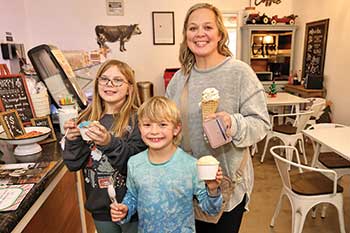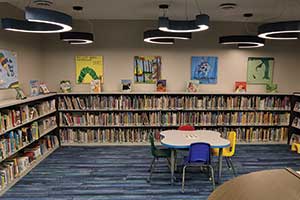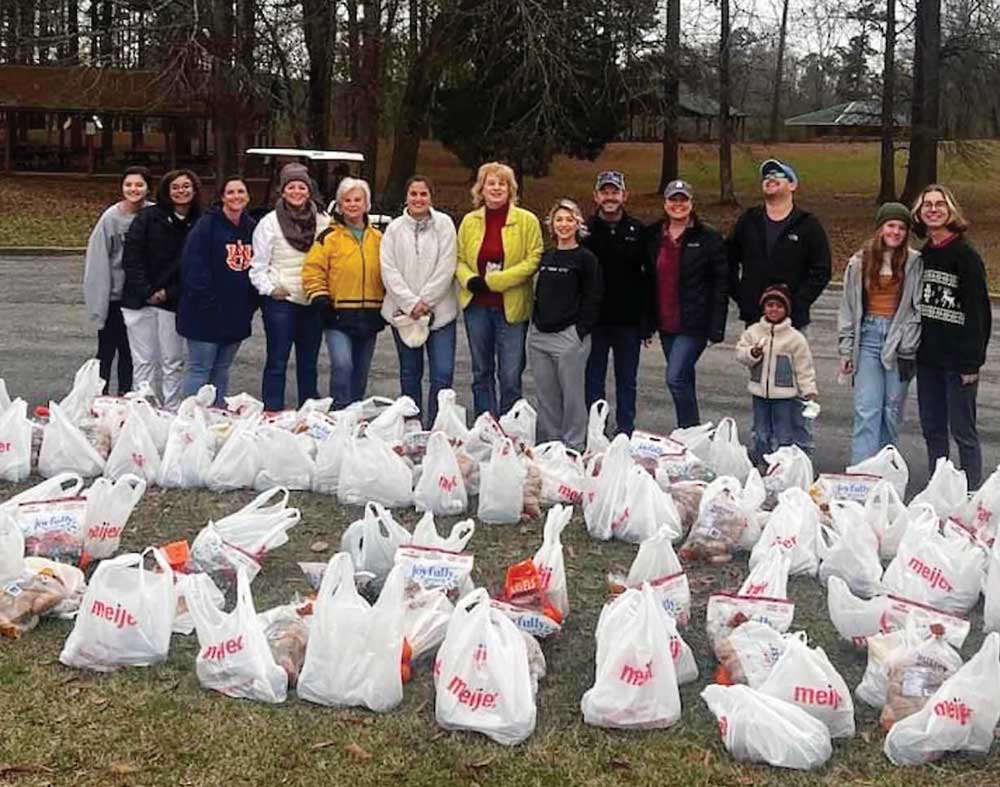Community bustling with economic growth
Story by Roxann Edsall
Photos by Richard Rybka
The sign above the coffee pot reads, “Even the darkest night will end, and the sun will rise.” That quote by author and playwright Victor Hugo is as much a part of the blueprint of Ashville’s newest business as is the smell of coffee that wafts through the cozy space. The story belongs to Holli Smith and Heather Warren, the sisters who own Lala’s. It’s a story of family, of love and loss, but it doesn’t end there.
The sign outside the building reads “Lala’s,” and a hot cup of coffee is just the beginning of their offerings. This place, located in the Ashville Historic District on the city’s courthouse square, is a bookstore with a bar where one can order hot and cold beverages, including various beers and wines. They also offer hot food options, with their stone-hearth oven pizza being a crowd favorite.
They just opened in December, but the owners’ plans include trivia nights, wine and beer tastings and live music. Heather and Holli’s grandmother’s piano sits against the wall just waiting to be played. The promise of a song is echoed by a nearby guitar.
The music stopped for the Smith and Warren families just over five years ago when Warren’s 19-year-old daughter, Haleigh, died from a pulmonary embolism. Haleigh’s nickname was Lala, a name given to her by her cousin, Smith’s son, Zander. “She loved reading, trivia, music and food, all the things we’ve decided to do here,” says Smith. “That quote over the bar is symbolic of our journey, coming out of that darkness.”
The bar itself is the handiwork of Smith’s husband, Merrell. It is crafted from red oak plywood and whiskey barrels. Tin tiles from the building’s former ceiling add character to the bar’s front wall.
More of the building’s history is evident throughout the business. The restroom door, a remnant from the days the space was used during the 2014 renovation of the courthouse across the street, reads, “Office of the Tax Collector.”
A large group table in the back is a refinished glass cutting table from the time when the space was used as storage for the adjacent Teague Mercantile business.
“During the renovation, we kept as much of the original structure as we could,” adds Smith. It was important to them to preserve the historical integrity of the building as much as possible. Smith’s son, Zander, is currently researching the building’s history for his fourth-grade history fair project.
The sisters both graduated from Ashville High School and now teach at that same school. Holli teaches Honors and AP English, while Heather teaches Honors and AP Science. Their love of travel is evidenced in the décor, maps, and pictures of many different countries hanging on the walls of Lala’s. “We’ve always talked about doing something like this,” says Smith. “We’d be traveling and visit a place like this and talk about how we could have our own coffee shop and bookstore.”
Their biggest blessing so far, the sisters say, has been the support of community. “We have been overwhelmed by the support of business neighbors and city leaders as well,” says Smith. “The soft openings were crazy! We weren’t prepared for the number of people who came out to support us.”
Reawakening ‘the square’
Just across the street, business neighbors Chad and Esther Smith agree that the community has been amazingly supportive of their clothing and gift store. They’ve just celebrated their first anniversary of business for Farm Wife and Company. Their hope is that more businesses will join them and create more foot traffic in the downtown square.
Chad calls it a “wild dream,” that plan that he and his wife, Esther, began to talk about a few short years ago. The couple, steeped in the farming community in St. Clair County, had talked about one day opening a small retail shop of some sort in Ashville.
They were already woven into the community as owners, with his brother and sister of nearby Smith Tomato LLC. The tomato farm, located in Steele, has a retail side where customers can visit the farm to purchase fresh produce and farm-branded products.
The two were busy helping to run the farm and the retail side of that business, but Esther and Chad Smith kept dreaming of opening their own retail shop. “Chad said I have that special touch for fashion and design,” says Esther. “We wanted to open a shop, but we didn’t want it to be a boutique. We wanted to be able to offer something for all ages.”
Their 1,800-square-foot storefront, Farm Wife and Company, is in court square in the heart of Ashville and is packed with a variety of unique giftware for all occasions and clothing for all ages. From wedding and baby gifts to special small-batch lotions made in Mooresville, Alabama, the inventory is unique and tasteful. There is even a men’s clothing and giftware section specifically designed by Chad.
He and Esther bought the old storefront before Thanksgiving in 2021 and began renovating it themselves, while also working on the farm. It was a labor of love that spanned a full year, before the store opened in December of 2022, just a month after Ashville’s bicentennial celebration.
The farm motif is interwoven throughout the store, from the farmer-specific quote behind the checkout desk to the barn façade that leads into the ice cream shop in the back of the store. “We see couples or people with kids come in and one person shops and the other comes to the back and sits down for ice cream or a cup of coffee,” says Chad.
The name Farm Wife and Company tells the story of their lives. Even her license plate says, “farm wife.” “We’ve always been in farming,” explains Esther. “We met on the farmland we now live on. My mother and both of my grandmothers were farmer’s wives, and Chad’s mother, too.
“We could have gone to a larger city, but we didn’t want to,” adds Esther. “Ashville needed it, and we wanted to open our store here.” They’ve just celebrated their first anniversary as a business. After initially intending to rent the space, they had the opportunity to buy it and jumped on it. “I think it was just God’s plan for us,” Esther says. “Everything just kind of fell into place. We had wanted to be on the square because it’s so visible and because the courthouse is so beautiful!”
Ashville Mayor Derrick Mostella is grateful for this small business and others who have brought the downtown area back to life.
“It’s those family businesses, like Farm Wife and Company, Lala’s, GNX and Little Art Tree, that represent us so well,” says Mostella. “They are the ones that set the tone for shopping local and keeping people invested in our town.”
Meanwhile, the city is doing its part, working on several projects to improve sidewalks, adding to the functionality of the downtown area. “We’ve got several projects in the works,” says Mostella. “We’re really sprucing up our park and recreation department and would love to be able to build a recreation center. We’re also looking at developing our land out near the interstate.”
Mostella campaigned prior to his election in 2016 on a promise to promote a downtown renaissance. “Business in downtown had gotten pretty bleak for a while,” he admits. “We always had those anchor businesses like Kell Realty, Charlie Robinson Law Offices, Sew Nice and Teague Mercantile. Then Dr. Labbe with Ashville Dental Center renovated the old pharmacy and relocated his business to the downtown. He was the first to realize the value of these old buildings.” Others soon followed.
GNX Gun Exchange opened in September of 2021 in an old bank building on the square. “It’s not your typical gun shop,” says co-owner Misty Thomas. “Since it was an old bank, we still have the vaults.” When she and her husband, Shane, went looking for a place to open their store, the bank building became available.
“We love being downtown,” adds Thomas. “It’s not a huge town, but they’re amazingly supportive. Events downtown are great. We always have a great turnout.” Events are held in the square for July 4th, Halloween, and Christmas, which promote foot traffic around the square, which encourages shopping at local merchants.
For Esther at Farm Wife and Company, being in the heart of downtown is part of the dream. She hopes that the growth of her store and others will help to make Ashville a place where people will want to come to spend time. “That would also allow us to do more and give back to the community,” she says. “We want to continue to serve others.”
Keeping the family atmosphere of a small town while promoting business development is a tricky balance for city leaders. Mayor Mostella says Ashville is handling that growth by simply remembering who they are.
“We are looking for growth, not for the sake of growth, but for growth that works with who we want to be,” he says. “We want to be able to offer different amenities, while still not outgrowing our small-town feel. It’s a balance.”


























